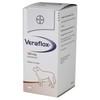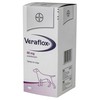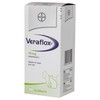Veraflox
Veraflox is an exceptionally effective veterinary fluoroquinolone antibiotic for the treatment of bacterial infections. It can treat a wide range of infections including skin and wound infections in cats and dogs, upper respiratory tract infections in cats, and urinary tract infections in dogs.
Veraflox is available in tablet form, in various strengths for both cats and dogs, and an oral suspension for cats. The tablets are brownish in colour and have been single scored so that they can be divided equally. The Oral Suspension is yellowish to beige in colour and can be administered directly by mouth.
Veraflox 120mg Flavoured Tablets
£5.50Veraflox 120mg Flavoured Tablets are indicated to treat a wide range of infections including skin and wound infections in dogs and cats, upper respiratory tract infections in cats, and...[More info]
Veraflox 60mg Flavoured Tablets
£3.59Veraflox 60mg Flavoured Tablets are indicated to treat a wide range of infections including skin and wound infections in dogs and cats, upper respiratory tract infections in cats, and...[More info]
Veraflox 15mg Flavoured Tablets
£1.49Veraflox 15mg Flavoured Tablets are indicated to treat a wide range of infections including skin and wound infections in dogs and cats, upper respiratory tract infections in cats, and...[More info]
Veraflox 25mg/ml Oral Suspension
£19.99Veraflox 25mg/ml Oral Suspension is approved for the treatment of skin infections (wounds and abscesses) in cats, as well as upper respiratory tract infections. Veraflox Oral Suspension...[More info]
Uses
Cats
Treatment of acute infections of the upper respiratory tract caused by susceptible strains of Pasteurella multocida, Escherichia coli and the Staphylococcus intermedius group (including S. pseudintermedius).
Dogs
Treatment of:
· wound infections caused by susceptible strains of the Staphylococcus intermedius group (including S. pseudintermedius)
· superficial and deep pyoderma caused by susceptible strains of the Staphylococcus intermedius group (including S. pseudintermedius)
· acute urinary tract infections caused by susceptible strains of Escherichia coli and the Staphylococcus intermedius group (including S. pseudintermedius) and
· as adjunctive treatment to mechanical or surgical periodontal therapy in the treatment of severe infections of the gingiva and periodontal tissues caused by susceptible strains of anaerobic organisms, for example Porphyromonas spp. and Prevotella spp.
Contra-indications, warnings, etc
Do not use in cases of hypersensitivity to the active substance or to any of the excipients.
Do not use during pregnancy and lactation.
Do not use in animals with central nervous system (CNS) disorders, such as epilepsy, as fluoroquinolones could possibly cause seizures in predisposed animals.
Cats: Due to the lack of data, pradofloxacin should not be used in kittens aged less than 6 weeks. Pradofloxacin has no effects on the developing cartilage of kittens of 6 weeks of age and older. However, the product should not be used in cats with persisting articular cartilage lesions, as these lesions may worsen during treatment with fluoroquinolones.
Dogs: Do not use in dogs during the period of growth as developing articular cartilage may be affected. The period of growth depends on the breed. For the majority of breeds, pradofloxacin-containing veterinary medicinal products must not be used in dogs of less than 12 months of age and in giant breeds less than 18 months.
Do not use in dogs with persisting articular cartilage lesions, since lesions may worsen during treatment with fluoroquinolones.
Whenever possible, the veterinary medicinal product should only be used based on susceptibility testing. Official and local antimicrobial policies should be taken into account when the veterinary medicinal product is used.
Fluoroquinolones should be reserved for the treatment of clinical conditions which have responded poorly, or are expected to respond poorly, to other classes of antimicrobials.
Use of the veterinary medicinal product deviating from instructions given in the SPC may increase the prevalence of bacteria resistant to the fluoroquinolones and may decrease the effectiveness of treatment with other fluoroquinolones due to the potential for cross-resistance.
Pyoderma occurs mostly secondary to an underlying disease, thus, it is advisable to determine the underlying cause and to treat the animal accordingly.
This veterinary medicinal product should only be used in severe cases of periodontal disease. Mechanical cleaning of teeth and removal of plaque and calculus or extraction of teeth are prerequisites for a persistent therapeutic effect. In case of gingivitis and periodontitis, the veterinary medicinal product should only be used as an adjunct to mechanical or surgical periodontal therapy. Only those dogs for which periodontal treatment goals cannot be achieved by mechanical treatment alone should be treated with this veterinary medicinal product.
Pradofloxacin may increase sensitivity of the skin to sunlight. During treatment, animals should therefore not be exposed to excessive sunlight.
Excretion via kidneys is an important elimination route for pradofloxacin in dogs. As for other fluoroquinolones, the renal excretion rate of pradofloxacin may be decreased in dogs with impaired kidney function and, therefore, pradofloxacin should be used with caution in such animals.
Mild transient gastro-intestinal disturbances including vomiting have been observed in rare cases in dogs and cats.
The frequency of adverse reactions is defined using the following convention:
- very common (more than 1 in 10 animals treated displaying adverse reactions)
- common (more than 1 but less than 10 animals in 100 animals treated)
- uncommon (more than 1 but less than 10 animals in 1,000 animals treated)
- rare (more than 1 but less than 10 animals in 10,000 animals treated)
- very rare (less than 1 animal in 10,000 animals treated, including isolated reports).
Concurrent administration with metal cations such as those contained in antacids or sucralfate made with magnesium hydroxide or aluminium hydroxide, or multivitamins containing iron or zinc, and dairy products containing calcium, has been reported to decrease the bioavailability of fluoroquinolones. Therefore, Veraflox should not be administered concurrently with antacids, sucralfate, multivitamins or dairy products, as absorption of Veraflox may be decreased.
Further, fluoroquinolones should not be used in combination with non-steroidal anti-inflammatory drugs (NSAIDs) in animals with a history of seizures because of potential pharmacodynamic interactions in the CNS.
The combination of fluoroquinolones with theophylline could increase the plasma levels of theophylline by altering its metabolism and thus should be avoided.
The combined use of fluoroquinolones with digoxin should also be avoided because of potentially increased oral bioavailability of digoxin.
No specific antidotes for pradofloxacin (or other fluoroquinolones) are known, therefore, in case of overdose, symptomatic treatment should be given.
Intermittent vomiting and soft faeces were observed in dogs after repeated oral administration of 2.7 times the maximum recommended dose. Infrequent vomiting was observed in cats after repeated oral administration of 2.7 times the maximum recommended dose.
User Safety
Due to potential harmful effects, the tablets must be kept out of the reach and sight of children.
People with known hypersensitivity to quinolones should avoid any contact with the veterinary medicinal product.
Avoid skin and eye contact with the veterinary medicinal product.
Wash hands after use.
Do not eat, drink or smoke while handling the veterinary medicinal product.
In case of accidental ingestion, seek medical advice and show the package leaflet or the label to the physician.
Environmental Safety
Any unused veterinary medicinal product or waste materials derived from such veterinary medicinal products should be disposed of in accordance with local requirements.



